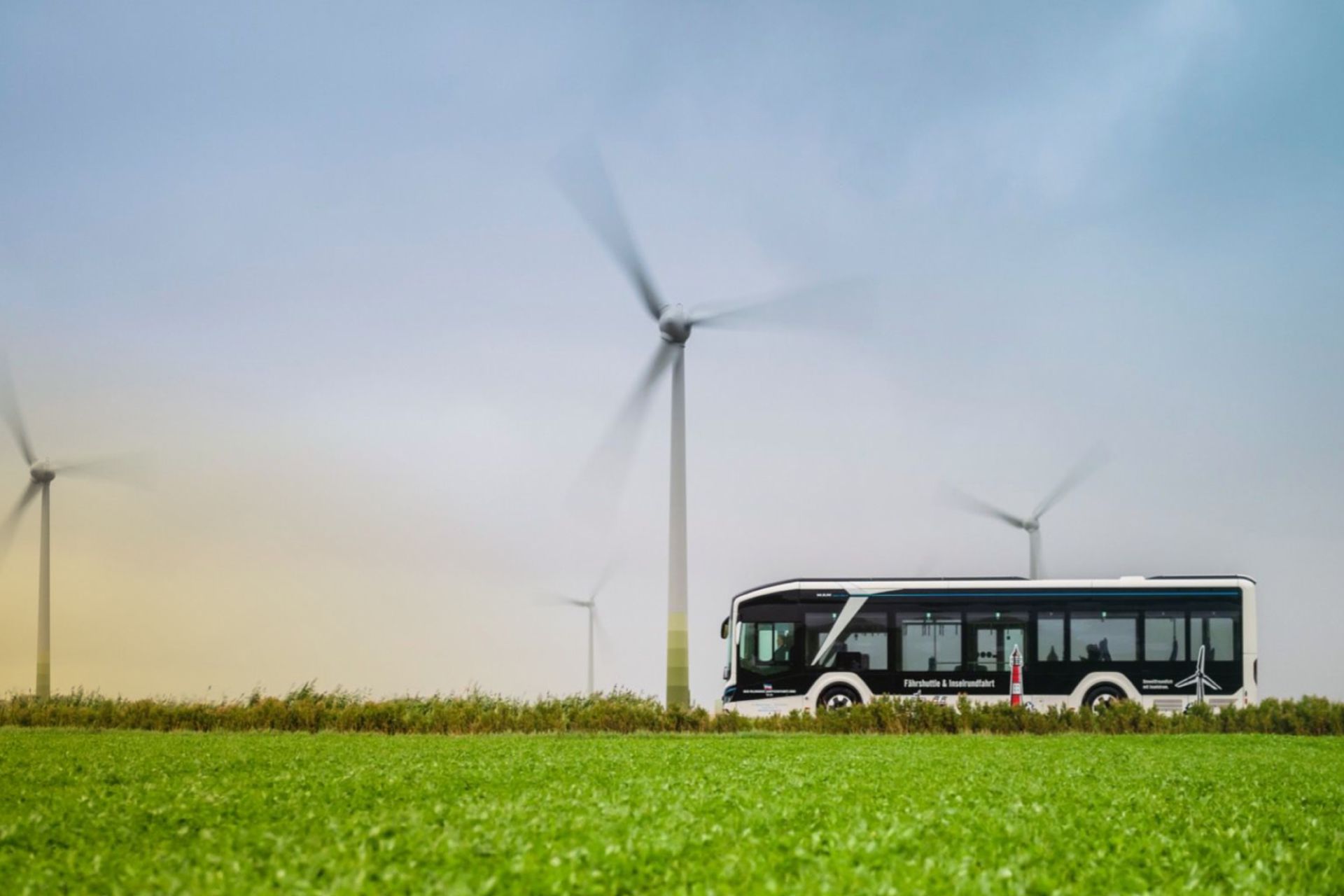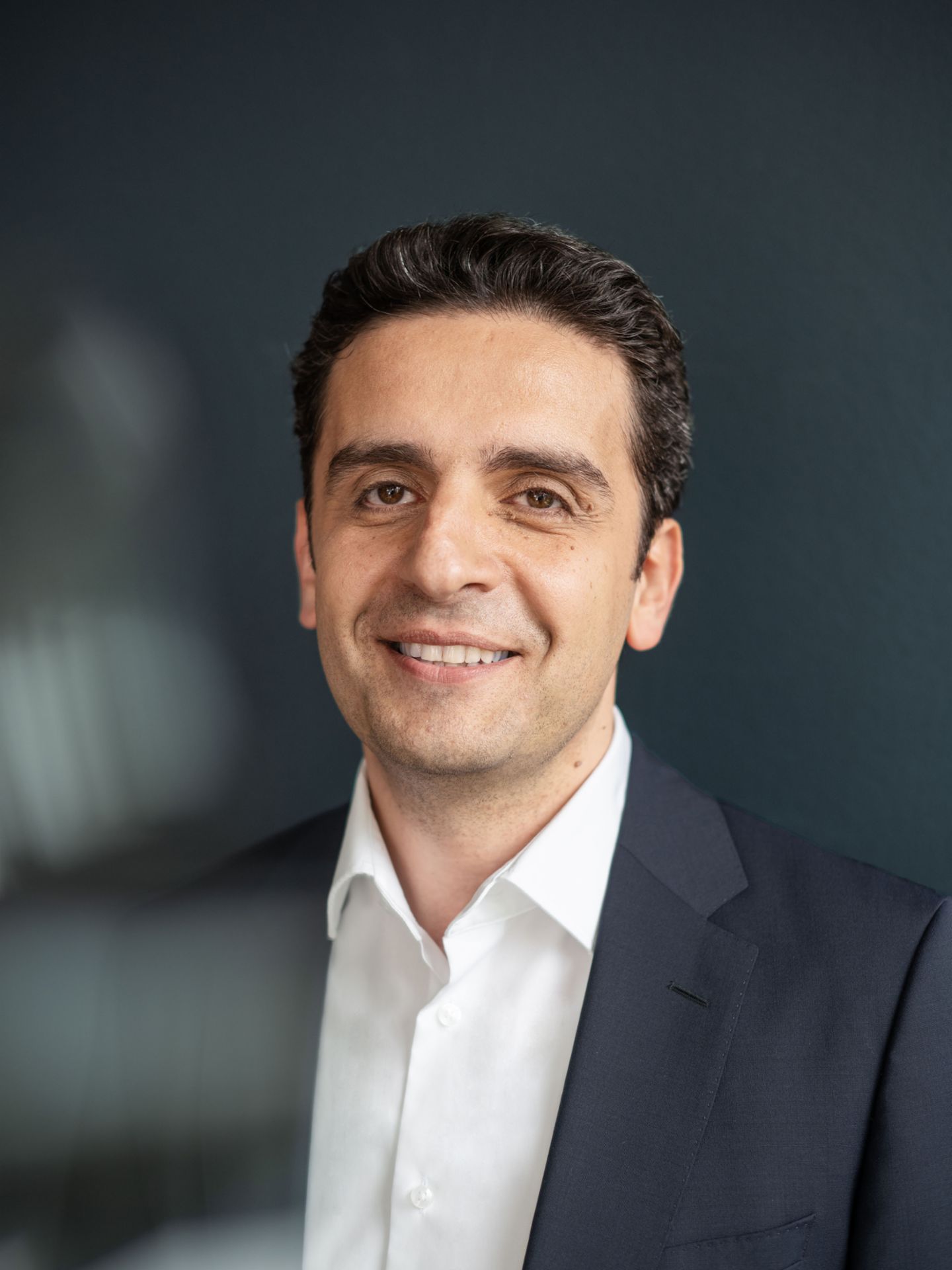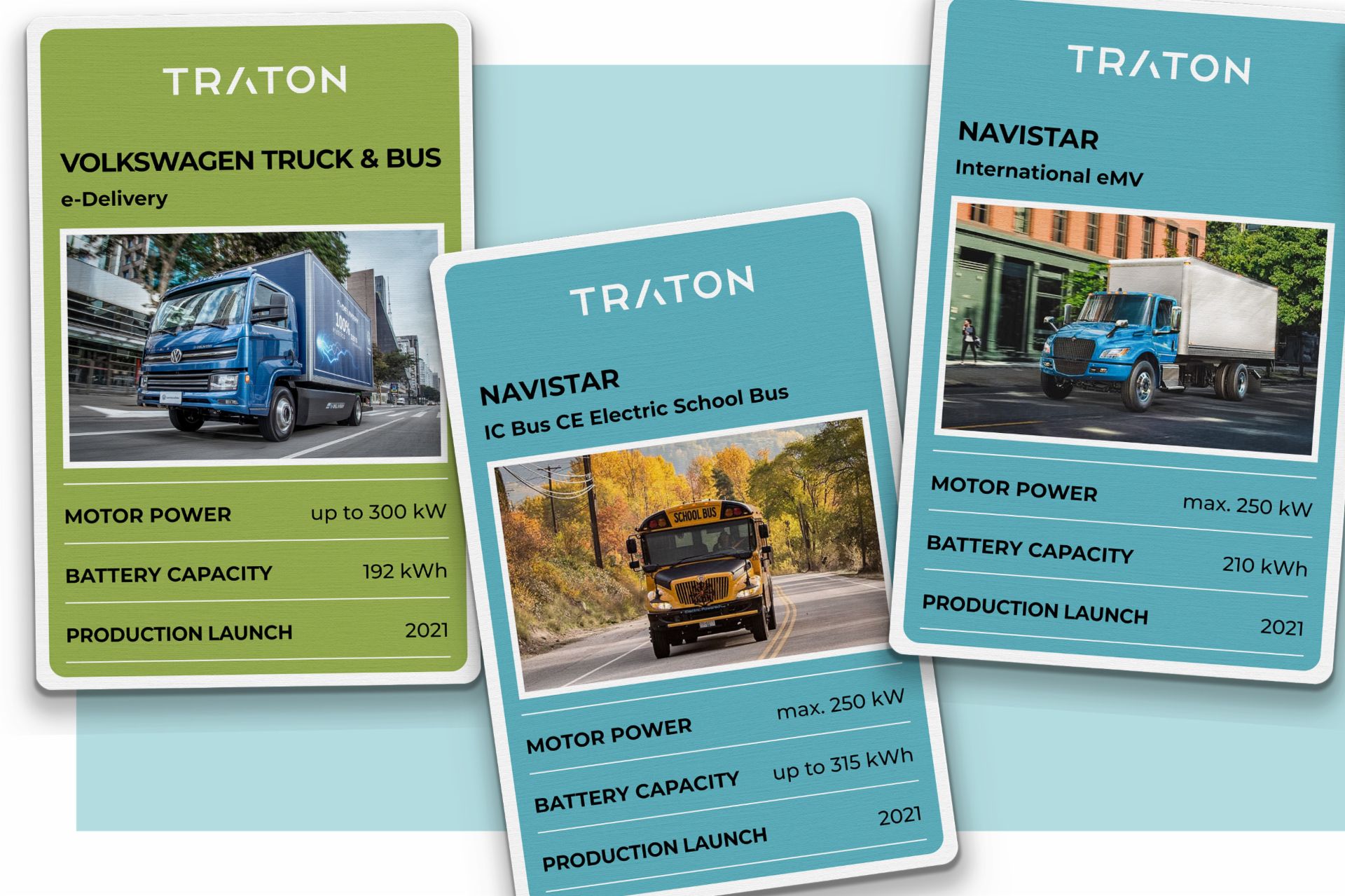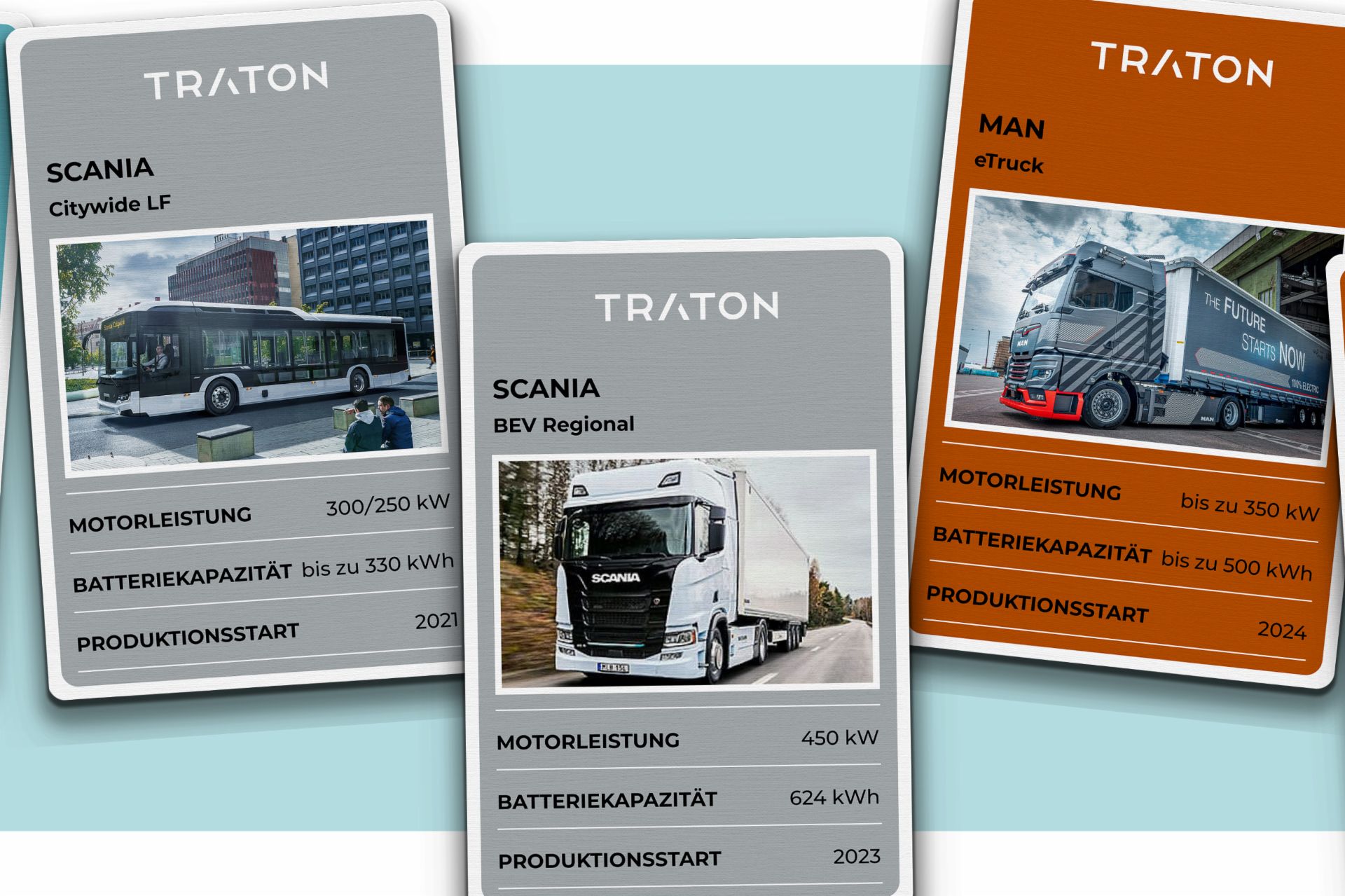The TRATON GROUP is working constructively to make this happen. For this vision to become a reality, politicians must create the necessary framework conditions – in particular massively expanding the charging infrastructure for the use of EVs – when it comes to freight transportation by road.
A lifeline for business and trade
More than 80% of all goods in Europe are transported overland by trucks. This makes freight transportation by road a lifeline for business and trade. Trucks are integrated into a multi-layered logistics chain, with other types of transport such as cargo ships and air freight depending on them as suppliers. The great advantage trucks have is their enormous flexibility in route planning and deployment. Buses are also part of the daily cityscape across Europe and indispensable for transporting people from A to B. According to the Federal Association of German Bus Operators (Bundesverband deutscher Omnibusunternehmer), 831,200 of these vehicles were on the road in Europe in 2018, and there are currently (2023) around 82,932 buses rolling along the roads in Germany. A good 35,000 of these are used as city buses in local public transport.
At the same time, around 8.1 million trucks (weighing 3.5 tons and over) and buses in Europe produce about one-third of CO2 emissions in road traffic today. This is also why the European Commission proposed stricter CO2 limits for these types of vehicles in its revision of the existing CO2 regulation for heavy-duty vehicles in February this year. The proposal also includes an extension of the current regulation for trucks that weigh five tons and above, as well as for coaches and city buses. This would mean that from 2030 onwards, CO2 emissions would be regulated for more than 98% of freight transportation by road in Europe. Until now this figure has stood at 73%. According to the European Commission’s proposal, new trucks must reduce their emissions by 90% by 2040, and all new city buses must be zero-emission as early as 2030. The European Commission, which has set itself a legally binding goal of making Europe climate-neutral by 2050, intends to set a new interim target of a 45% CO2 reduction (previously –30%) for 2030 compared to 2019 and is aiming for a new figure of 65% for 2035. The European Parliament and EU member states must agree in order for the proposal to become law. The draft can still be amended.
The European Commission’s ambitious proposal
For the umbrella organization of European truck manufacturers, the European Automobile Manufacturers’ Association (ACEA), and its Director General Sigrid de Vries, the European Commission’s plans are “highly ambitious.” Their main criticism is that the plans for the new CO2 limits have not been coordinated with the new strict Euro 7 exhaust emissions standard. The European Commission had previously published its Euro 7 proposals in November 2022. De Vries is also skeptical about whether the network development of a commercial vehicle-specific charging infrastructure for electric trucks that do not produce any CO2 emissions could even keep up with the proposals on CO2 reduction in the first place. “Considering there are virtually no charging stations tailored to the specific needs of trucks right now, the challenge is enormous,” says ACEA Director General Sigrid de Vries.
The German Association of the Automotive Industry (Verband der Automobilindustrie, VDA) also views the European Commission’s plans with caution. Commenting on the plans from Brussels, VDA President Hildegard Müller describes the draft legislation presented as extremely ambitious given that existing charging infrastructure has so far been inadequate. Müller concludes that without speed and determination in the necessary framework conditions, especially the corresponding investments in infrastructure, this goal will be virtually impossible to achieve. She adds that if the European Commission wants to implement its ambitious goals, it must ensure these very conditions. As well as guaranteeing an adequate supply of vehicles, this also means delivering a sufficiently dense network of electric charging stations for heavy-duty commercial vehicles throughout Europe. For Hildegard Müller, it is also clear: “Trucks and buses that do not produce any CO2 emissions will only be included in the fleets in large numbers when operating battery electric vehicles becomes more profitable than operating vehicles with conventional engines.” Consequently, replacing existing vehicles in fleets with zero-emission ones can only happen across the board if sufficient incentives are created for haulage companies and transport operators. Müller mentions subsidies, toll exemptions, and tax breaks for low-carbon trucks and buses as examples. “This is the only way we can encourage and empower haulage companies and transport operators to invest sufficiently in zero-emission vehicles.”
Battery electric mobility is the future of the transport sector
Although the corresponding charging infrastructure for e-mobility is largely not yet available in Europe, the use of e-trucks and e-buses (so-called BEVs = battery electric vehicles) has already increased overall. This is partly because Germany, for example, is pushing the use of e-mobility politically, creating incentives for the purchase and use of e-trucks and e-buses and promoting depot charging. This means that in many large cities in this country, e-buses are now part of the cityscape in local public transport. 1,617 battery-powered buses are currently on the road in Germany. The cities of Berlin and Hamburg alone are planning to purchase over 1,500 e-buses each by 2030. At least 35,000 zero-emission buses will be needed for local public transport in total by 2030.
For Dirk Höke, the TRATON GROUP’s Head of Governmental Relations, this underscores the Company’s strategy. “The TRATON GROUP and its brands Scania, MAN, Navistar, and Volkswagen Truck & Bus are ready to support transport companies in transitioning their bus fleets to zero-emission vehicles. Buses and coaches already have a lower environmental impact, and the TRATON GROUP’s commitment will help it become a pioneer in tackling climate change.”
Sweden is also one of Europe’s pioneers in the use of e-mobility and is focusing on the logistics sector to reduce the carbon footprint of trucks and buses. That is why the Swedish government also consistently supports the expansion of charging infrastructure along roads and highways. The southern part of this Scandinavian country is particularly well supplied with charging stations, which are primarily located along the main traffic axes and around larger cities, such as in Stockholm and Gothenburg or along the E4 and E20 routes. However, there is currently no charging network in place for trucks according to the so-called Megawatt Charging System (MCS) standard. The European public sees electric mobility as a great opportunity to reduce CO2 emissions and therefore tackle climate change, while at the same time supporting domestic industry and creating jobs.
“For 10,000 long-haul trucks that we electrify earlier, we can reduce CO2 emissions by up to one million tons of carbon dioxide per year. The TRATON GROUP will provide the necessary BEV trucks with its brands.”
Atif Askar Head of Business Development, Strategy, and M&A in the TRATON GROUP
Ready for vehicles with lower environmental impact
Atif Askar, Head of Business Development, Strategy and M&A in the TRATON GROUP, explains the potential that the switch to battery electric vehicles holds for tackling climate change: “For 10,000 long-haul trucks that we electrify earlier, we can reduce CO2 emissions by up to one million tons of carbon dioxide per year, which is enormous. At the same time, battery-powered trucks will have a better total cost of ownership, especially in long-haul transportation, because energy costs are most dominant here and correlate with energy efficiency. The TRATON GROUP will provide the necessary electric trucks through its brands. However, developing a dedicated fast charging infrastructure for trucks is essential. TRATON is supporting this through its charging joint venture, Milence.”
The TRATON GROUP and its brands are ready to do their bit for decarbonization. Scania offers an all-electric 26-ton truck, MAN manufactures e-buses and vans, while Navistar’s IC Bus brand produces electric school buses, and Volkswagen Truck & Bus has built a 14-ton e-Delivery truck. Scania will unveil a 40-ton all-electric truck at the end of 2023, while MAN’s future eTruck will arrive at the end of 2024.
There is no doubt that long-haul transport has the greatest potential for avoiding CO2 emissions. This is where the most kilometers are driven, so for purely financial reasons, electric trucks will establish themselves very quickly in this sector too.
The framework conditions must be right
The Company is already driving electrification forward, as demonstrated by Scania’s investment in a battery assembly and chassis line in Södertälje and MAN’s battery production in Nuremberg. However, the ambitious climate targets of TRATON, brands, and the European Commission can only be achieved with the help of the right framework conditions. The carbon-neutral freight transport envisioned in the European Commission’s proposal requires the establishment and expansion of high-performance charging infrastructure for battery electric trucks in the respective EU member states. This is an enormous task for political decision-makers, since the ACEA assumes that 50,000 charging points will be needed for heavy-duty commercial vehicles in Europe by 2030. Of these, 35,000 will be ultra-fast MCSs and 15,000 will be Combined Charging Systems (CCSs) that are ,also used by passenger cars.
The EU institutions have taken a first step in this direction and ratified the binding expansion of charging infrastructure for electric cars in Europe. By 2026, public charging points must be available to drivers at least every 60 kilometers along the EU’s main roads. According to the Alternative Fuels Infrastructure Regulation (AFIR), EU member states are obliged to install around 5,000 MCS charging points in total by 2030. However, this is nowhere near ambitious enough and only equivalent to 10% of the requirement proposed by the ACEA. Speaking at the Parliamentary Evening at the Swedish Embassy in Berlin on May 11, 2023, Christian Levin, CEO of the TRATON GROUP and CEO of Scania, said: “The technology for the transition to sustainable transportation is ready — for trucks and buses and for charging stations. The TRATON GROUP brands have already proved that their battery electric vehicles are suitable for everyday use and can withstand even the harshest of conditions. We now need the right political roadmap, framework, and incentives so that we can build a high-performance European charging network at the required speed. This would then pave the way for the European Union to reach its climate goals.”
“Now we need the right political course, framework conditions and incentives to be able to build an efficient pan-European charging network that is fast enough to pave the way for the European Union to achieve its climate targets.”
Christian Levin Chief Executive Officer of TRATON SE and Chief Executive Officer Scania
There is no doubt about it: the path to a carbon-neutral future is a challenge — one that is demanding and definitely a marathon, not a sprint. The electrification of buses and trucks will play a key role in achieving Europe’s climate targets: in the next ten years, the fleet of battery electric heavy-duty commercial vehicles in Europe is expected to grow to more than one million. A total market of ten million medium and heavy trucks and buses (weighing 3.5 tons and over) is waiting to be decarbonized. The TRATON GROUP and its Scania, MAN, Navistar, and Volkswagen Truck & Bus brands are ready to supply the market and meet its many different needs. MAN, for example, has won important major customers for the market launch of its battery electric long-haul truck in 2024, and more than 500 pre-orders have already been placed. Scania will follow its 2022 launch of a battery electric truck for regional transport with the introduction of a long-haul truck before the end of 2023. The Swedish brand’s cooperation with battery manufacturer Northvolt shows that battery cells will not be a limiting factor for electric commercial vehicles. On the contrary: one set of batteries is enough to last a truck over 1.5 million kilometers — its entire lifetime.
-
The TRATON GROUP believes that the following elements have to be implemented quickly:
First, access to green electricity and high-capacity charging infrastructure in the EU must be guaranteed. Europe needs faster planning when it comes to the expansion and design of the electricity grid with the highest charging capacities according to the new MCS standard.
Second, price parity between electric and fossil-fueled transport needs to be established. For example, a battery electric truck today costs two to three times as much as a conventional diesel truck. This means that the fuel costs for diesel compared to electricity will have a major impact.
Third, Europe needs efficient carbon pricing measures, including CO2-based tolls and the introduction of the Emissions Trading Scheme (ETS II) for transport with high CO2 prices, to accelerate the transition to a fossil-free future. After all, if electric vehicles are offered at costs comparable to their fossil-fueled counterparts and the necessary MCS charging infrastructure is in place, it will make sense for customers to decide in favor of electric transport.
Fourth, the targets set out in the Alternative Fuels Infrastructure Regulation (AFIR) need to become more ambitious — in order to effectively support the goal of introducing e-trucks to market rapidly. The AFIR should therefore be reviewed earlier than agreed, and the fulfilment of the new CO2 limits should be monitored annually in relation to the development of charging infrastructure. That way, it will be possible to identify any discrepancies between the number of registrations of zero-emission commercial vehicles and the availability of the infrastructure at an early stage.
Last but not least, it makes sense to synchronize the new Euro 7 emissions standard for diesel engines proposed by the European Commission with the revision of the CO2 regulation for heavy-duty commercial vehicles. Additionally, feasible limits and boundary conditions should be set so that technical and financial resources are not shifted from battery electric back to fossil-fueled vehicles. High levels of investment in a technology that is being phased out would significantly slow down the transition to electric zero-emission transport. A combination of accelerated electrification and phasing out of older vehicles would have a much greater effect on air quality. -
The European Parliament, the Council of the European Union, and the European Commission will open the trialogue on the revision of the CO2 regulation for heavy-duty commercial vehicles in the coming months. The goal should be to reach a quick agreement on the revision of the existing CO2 regulation for heavy-duty vehicles, so that all parties involved have planning certainty. This will also send a strong signal that no time will be lost when it comes to tackling climate change and decarbonizing freight transportation by road. That is why TRATON and its brands have joined forces with other major commercial vehicle manufacturers (Daimler Truck and the Volvo Group) and founded the Milence joint venture.
Over the next four years, the partners will invest a total of half a billion euros, which will be used to build at least 1,700 high-performance charging points throughout Europe. The charging points are set to run on green energy and be compatible with vehicles from all brands. This is an important starting point and serves as the basis for the critical mass that is needed to get the system up and running. It also clearly signals to the market and customers that manufacturers are ready for the transformation.








